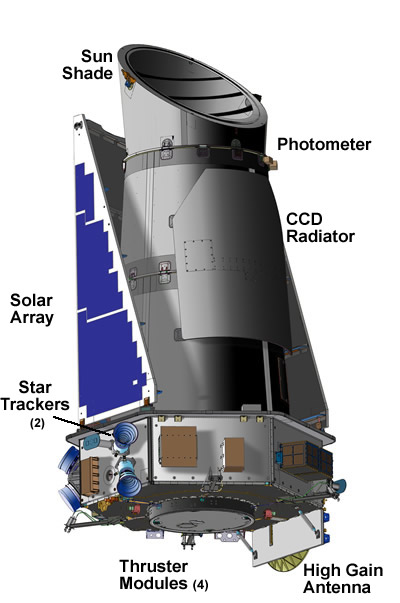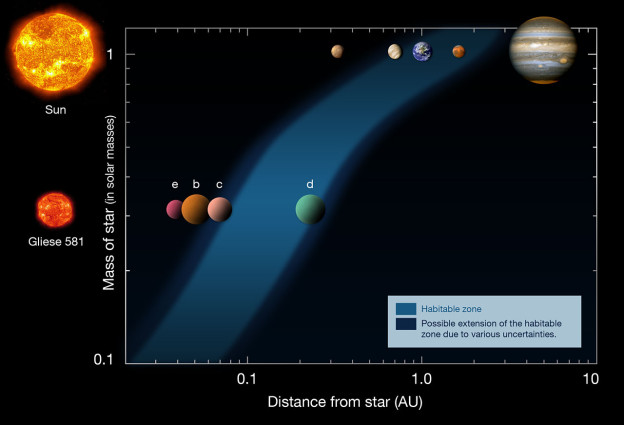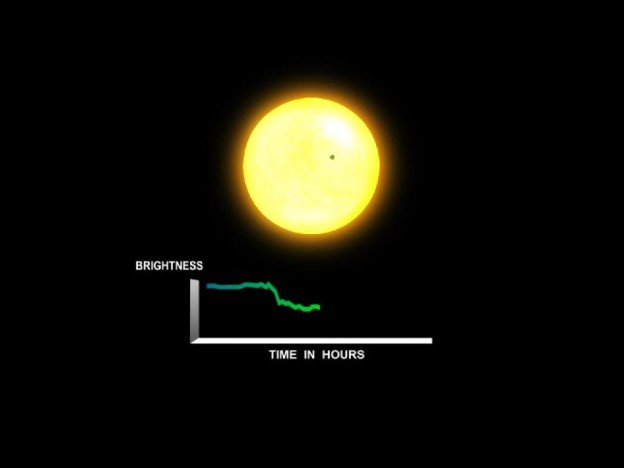Several satellites and ground-based telescopes are dedicated to looking for potential life elsewhere in the universe, among them is the American Kepler satellite. Kepler is NASA’s first mission capable of finding Earth-size and smaller planets around other stars.
The project is well- known, but few know of the Danish participation in the project. As one of the Co-investigators Professor Jørgen Christensen-Dalsgaard, at the University of Aarhus, participates in the project and has written an article for NordicSpace.
Denmark’s Participation in the Kepler Mission
Professor Jørgen Christensen-Dalsgaard, University of Aarhus, Denmark

The Kepler satellite and the instruments.
Credit: NASA
Kepler is a NASA Discovery mission, with the primary scientific goal to characterize planetary systems around other stars, and in particular determine the fraction of Earth-size planets in the habitable zone around their stars, where the planetary temperature is such as to allow liquid water. These so-called exo-planets are detected using the transit technique, by observing the small reduction in the light of a star when a planet passes in front of it. It is obvious that only for a small fraction of systems will the orientation of the planetary orbits be aligned such that transits happen, as seen from the spacecraft. Thus, to ensure a reasonable statistics for planet detection, Kepler observes around 150,000 stars continuously for several years in a field located in the constellations Lyra and Cygnus. The observed effects are tiny: since the diameter of the Earth is only 1 % of the diameter of the Sun, the transit of a planet like the Earth in front of a star like the Sun causes a relative reduction of only 0.01 % of the light of the star. Thus, a crucial requirement for the mission is extremely high photometric accuracy. Kepler was launched in March 2009 into an Earth-trailing heliocentric orbit with a period of around 53 weeks; thus the spacecraft gradually moves further away from Earth.
Kepler has been remarkably successful in detecting what is termed exo-planet candidates, where probably transit events have been found. The last released catalogue (7 February 2014) contained 3538 such candidates, and it is estimated that at least 80 % 246 are planets. On this basis, given the detection probability, it seems that the majority of stars in the Milky Way have planetary systems. To qualify as true exo-planets such detected candidate systems have to be further studied to ensure that the signal is not due to other phenomena, such as a more distant eclipsing binary. A striking result has been the detection of many multi-planet systems, including cases where the mutual gravitational interaction between the planets has allowed determination of planet masses.
It was obvious from the outset that the photometric quality of the observations and the planned very long and continuous observations made the mission ideally suited also for studying also other types of variability in stars. A particularly interesting example is the study of stellar oscillations. The analysis of solar oscillation frequencies has allowed helioseismic investigations, which have provided detailed information about the properties of solar interiors. Similar, although less detailed information may be expected from asteroseismic observations of oscillations in solar-like stars; the expected amplitudes of such oscillations, a few parts per million in luminosity, mean that photometric observations are only possible from space. Although most of Kepler’s observations are carried out at a cadence of one per 30 minutes, the oscillation periods of solar-like stars of a few minutes require a higher cadence. Thus, the design of Kepler allows the observation of up to 512 stars at a one-minute cadence. These high-cadence data can also be used to a more detailed characterization of transits across relatively bright stars.
Although asteroseismology was planned as a component of the Kepler mission from the outset, the available funding was inadequate to develop it as part of the NASA project. This led to an invitation from the project to the stellar-physics group at Department of Physics and Astronomy, Aarhus University, to join the project to be responsible for the asteroseismic analysis of Kepler data. A major motivation was the potential to use asteroseismology to characterize some of the stars around which planetary systems were detected. From the observations the diameter and mass of the star, and in many cases also its age, can be determined. Knowing the stellar diameter is required to determine the diameter of a planet from the depth of the observed transit, while the stellar age obviously provides a determination of the age of the planetary system. However, a major goal of the planned asteroseismic analysis was also a more general investigation of stellar properties, covering the large sample of stars that show oscillations of various kinds. An agreement was established, formalized in a Letter of Direction from the Principal Investigator, W. Borucki, of the Kepler mission setting out the conditions for the collaboration, and the author was included as Co-Investigator.
It was obvious that the Aarhus group could not deal adequately with the very large amount of asteroseismic data to be expected from Kepler. Thus, an international collaboration on the use of the data was set up in the Kepler Asteroseismic Consortium (KASC). Membership in KASC was open, subject to the signing of a non-disclosure agreement blocking the premature release of the potential detection of an exo-planet. KASC has now reached more than 550 members, organized in working groups dealing with various types of stars. This organization has led to a highly efficient and productive collaboration on the use of the Kepler data. The data are provided to the KASC members from the Kepler Asteroseismic Science Operations Centre (KASOC), located in Aarhus, which also serves to distribute other relevant data and results of the analysis, as well as to facilitate the review of the resulting papers.
The asteroseismic results have met and probably exceeded even the most optimistic expectations before the launch. From an early survey phase solar-like oscillations were detected in more than 2165 (7 February 2014) stars on or near the main sequence where the stars burn hydrogen in their central region. This represents an increase by about a factor 20 of such stars known to show oscillations. This has allowed population studies of stars in the solar neighbourhood, constraining models of the evolution of the Milky Way Galaxy. Even more striking have been the results for more evolved stars. While the oscillations observed in the Sun are standing acoustic waves, in more evolved stars we also see oscillations, which in part have the character of standing internal gravity waves predominantly associated with the core of the star. Such mixed modes provide information about the structure and rotation of the deep interior of the stars. For red-giant stars, representing a late stage of the evolution of our own Sun, this has allowed us to distinguish between stars where the energy comes just from hydrogen fusion around a central helium core and stars where in addition there is fusion of helium to carbon in the central region. In addition, we have found that the cores of these stars rotate much more rapidly than the surface layers. These results are providing entirely new constraints on our understanding of stellar structure and evolution.

The habitable zone for Earth like planets. Credit: NASA
In addition to these stars showing solar-like oscillations, Kepler has provided data on a broad range of pulsating stars. These include the so-called RR Lyrae stars, whose oscillations have relatively large amplitude but show variations that are so far not understood. Another very interesting type of stars are very compact and hot helium burning stars near the end of their life, where the Kepler results allow detailed investigations of the internal properties of the stars.
An important aspect of Kepler asteroseismology is the characterization of planet-hosting stars. This has been organized in a special group under KASOC, to provide efficient and timely analysis as the data become available. Important examples of these efforts are the determination of the properties of the star where the first secure identification of a rocky planet outside the solar system was made, and the case of a star hosting a planet in the habitable zone with a diameter just over twice the diameter of the Earth.
Although much of the Danish effort in the Kepler project is based in Aarhus, there are important activities at the Niels Bohr Institute in Copenhagen. These are largely concerned with the characterization of the exo-planets and their host stars through more classical astrophysical observations. An important contribution has been in the exclusion of false positives, i.e., cases where an apparent transit has been found to have causes other than an exo-planet. In addition, very interesting work has been carried out on the composition of planet-hosting stars, showing that, unlike systems with giant planets, there is no tendency that stars with Neptune-size planets or smaller have an unusual high abundance of heavier elements.
The Kepler mission has now been extended for years, greatly increasing the possibility to characterize the distribution of Earth-size planets and the potential asteroseismology of extremely high precision. As part of the extension, all Kepler data now become public immediately. This will lead to a reorganization of KASC, but it is expected that the fruitful collaborations established in the initial phases of the mission will continue and greatly contribute to our developing understanding of stellar structure and evolution and stellar internal physics.
Are there planets orbiting other stars with characteristics similar to Earth? In recent years, scientists have discovered nearly 400 stars with orbiting giant planets. The challenge is to find terrestrial planets, those one-half to twice the size of the Earth, and especially those in the “habitable zone” of their stars where liquid water and possibly life might exist. We might soon find answers with Kepler – the first mission capable of detecting Earth-size and smaller planets in or near the habitable zone.
The operations phase of the Kepler mission is managed for NASA by the Ames Research Center, Moffett Field, CA. NASA’s Jet Propulsion Laboratory (JPL), Pasadena, CA, managed the mission through development, launch and the start of science operations. Dr. William Borucki of NASA Ames is the mission’s Science Principal Investigator. Ball Aerospace and Technologies Corp., Boulder, CO, developed the Kepler flight system.
In October 2009, oversight of the Kepler project was transferred from the Discovery Program at NASA’s Marshall Space Flight Center, Huntsville, AL, to the Exoplanet Exploration Program at JPL.
The Transit Method

The Transit Method. Credit:: University of Aarhus. Denmark
When a planet passes in front of a star as viewed from Earth, the event is called a “transit”. On Earth, we can observe an occasional Venus or Mercury transit. These events are seen as a small black dot creeping across the Sun—Venus or Mercury blocks sunlight as the planet moves between the Sun and us. Kepler finds planets by looking for tiny dips in the brightness of a star when a planet crosses in front of it—we say the planet transits the star.
Once detected, the planet’s orbital size can be calculated from the period (how long it takes the planet to orbit once around the star) and the mass of the star using Kepler’s Third Law of planetary motion. The size of the planet is found from the depth of the transit (how much the brightness of the star drops) and the size of the star. From the orbital size and the temperature of the star, the planet’s characteristic temperature can be calculated. From this the question of whether or not the planet is habitable (not necessarily inhabited) can be answered.
Kepler instrument
The Kepler instrument is a specially designed 0.95-meter diameter telescope called a photometer or light meter. It has a very large field of view for an astronomical telescope — 105 square degrees, which is comparable to the area of your hand held at arm’s length. It needs that large a field in order to observe the necessary large number of stars. It stares at the same star field for the entire mission and continuously and simultaneously monitors the brightness of more than 100,000 stars for the life of the mission—3.5 or more years.
The photometer must be space-based to obtain the photometric precision needed to reliably see an Earth-like transit and to avoid interruptions caused by day-night cycles, seasonal cycles and atmospheric perturbations, such as, extinction associated with ground-based observing.


